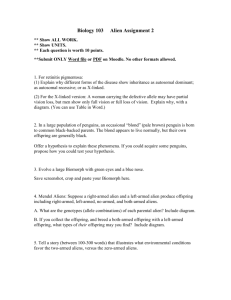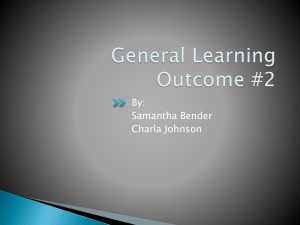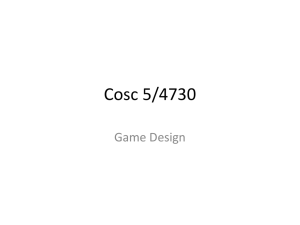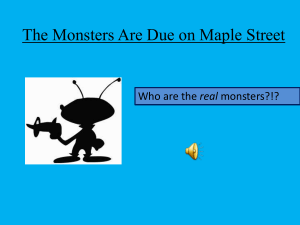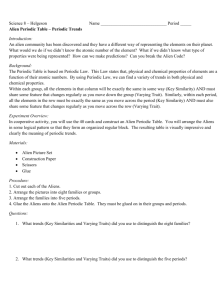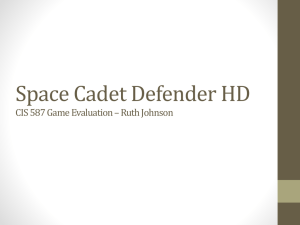Description_of_ESI0106881_Data_Archive
advertisement
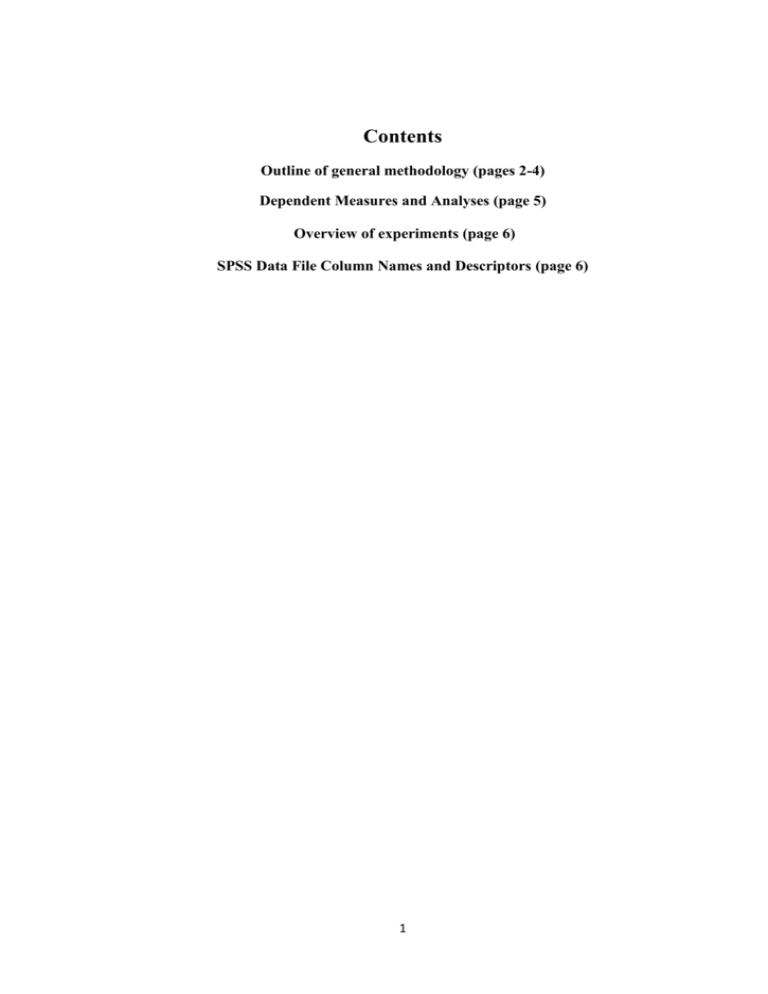
Contents Outline of general methodology (pages 2-4) Dependent Measures and Analyses (page 5) Overview of experiments (page 6) SPSS Data File Column Names and Descriptors (page 6) 1 Outline of general methodology Utilizing a linear-diffusion-chain methodology similar to that previously used to investigate how artificial languages evolve (Kirby et al., 2008), we examined whether passing social information down a chain comprising multiple “generations” of individuals would result in the spontaneous formation of stereotypes. To provide novel social targets that were individually unique but also shared category membership, we created 27 “alien beings” by combining three category dimensions that each had three possible features (Fig. 1). We initialized each chain by randomly assigning six personality attributes to each alien (Generation 0; Fig. 2). During an initial training phase, the first participant in a chain (Generation 1) attempted to learn the associations between a subset of aliens and their attributes. During a subsequent recall phase, the participant was shown all 27 aliens and asked to identify the attributes associated with each. A subset of the aliens and the attributes that the participant had associated with them at test were used as the training materials for the next participant in the chain (i.e., Generation 2). The process of using the test responses from one generation as the training materials for the next was repeated seven times per chain to create socialtransmission chains of eight generations (i.e., Generations 0–7). Figure 1. Aliens’ possible features for each category dimension (top panel) and example trainingphase display showing an alien stimulus with its associated attributes (bottom panel). Participants and Design Participants (n = 49; see Kirby et al., 2008) were be recruited for each experiment from the University of Aberdeen undergraduate participation pool. Participants in each experiment are assigned to a single generation (i.e., generation 1-7) in one of seven different diffusion chains. Each of the 7 chains in an experiment is effectively treated as a single “participant”, while each generation in a chain (individual participant) is treated as a “level” of a repeated measures factor. Each participant will complete a learning phase and a memory test phase. Participants 1-7 are randomly assigned to generation 1 of a different diffusion chain. Each diffusion chain differs in the random allocation of traits at generation one, such that each begins with a different random association of traits and aliens. Participants 8-14 are assigned to generation 2 and learn from the test responses of the first participant in their respective chains; each of the next 7 participants is assigned to generation 3 of the chains and learn from the second participants test responses; and so on for 7 generations. 2 Materials Alien images: There are 27 alien stimuli in the experiment, each represented by a line drawing of a simple geometric shape, with eyes and an arrow indicating means of movement. Each of the 3 alien features varies along 3 possible dimensions (i.e., Shape: square, circle, triangle; Colour: red, green, blue; Movement: horizontal, diagonal, bouncing; Figure 1 top panel). Thus while every individual alien image is unique, each also shares some categorical characteristics with other aliens (i.e., shape, movement, number of eyes). Alien trait attributes: The basic design of the experiment (Expt. 1) uses forty-eight attribute traits, which could describe a human (e.g., caring, helpful, sincere). Subsequent experiments use additional trait lists (Expt. 2: non-human traits; Expt. 3: additional human traits; Expt. 4: existing stereotyped traits; Expt. 5: positive, negative & neutral traits). Where possible, trait lists will be generated from suitable items in existing rated databases (e.g., Gough & Heilbun, 1980). Where there will be trait list comparisons between experiments or within an experiment (i.e., Expt. 1 vs. Expt. 2; Expt. 4; Expt. 5), every effort will be made to match across the lists for word length, syllable length and usage/familiarity. To ensure their suitability for inclusion, all traits will be rated for familiarity, valence and stereotypic association by a sample of participants drawn from a demographic similar to those who will participate in the experiments (i.e., undergraduate students). Stimulus sets (generation 1): The stimulus sets for the different chains at generation 1 are created by randomly assigning 6 different attribute traits to each alien (Figure 1 bottom panel). The aliens are then divided into two sets, one containing 13 aliens (seen set) and the other containing 14 aliens (unseen set). The 13 aliens and associated traits in the seen set are used during the learning phase. The 14 aliens in the unseen set remain hidden until the test phase. This procedure is conducted 7 times in order to produce unique stimulus sets at generation 1 of each of the 7 chains. Learning phase: Participants are informed that they will see a series of images of “aliens” along with 6 traits that describe each one and that the task is to remember which traits describe which aliens. During the learning phase participants see the 13 aliens and associated traits from the seen set. In each trial they view an alien image and read the associated six traits. In order to facilitate learning of the alien/trait pairings, each alien from the seen set is viewed 3 times (i.e., 39 trials). Test phase: Participants are told that they will see some images of aliens and they have to decide which 6 traits they think belong with which aliens. During the test phase participants are required to make responses to all 27 of the aliens – both the 13 seen and 14 unseen items (i.e., 27 individual trials). In each trial participants view an image of an alien and a list of all 48 of the traits used during the experiment. Participants are asked to indicate, by ticking an onscreen check-box, which 6 traits are associated with the depicted alien image and to make their best guess if they are unsure. Participants are not informed that the test phase will include any unseen aliens; debriefing of pilot study participants revealed they were unaware that the test phase included previously unseen aliens. Stimulus sets (generations 2-7): For each chain, the alien/trait associations for all subsequent generations are created from the output of the previous generation. The test phase responses from the previous generation are randomly divided into new seen and unseen sets. The newly created seen items set are then presented during the learning phase for the next generation and they are then in turn tested on both the seen and unseen sets This process continues from generation to generation within each chain, such that each new generation’s learning phase comprises 13 randomly selected aliens from the previous generation’s test phase (Figure 2). 3 Figure 2. Schematic illustrating the processes of social transmission of information across multiple generations in the linear-diffusion-chain method. At the beginning of each chain (Generation 0), each alien was randomly assigned six personality attributes. The first participant in a chain (Generation 1) learned the associations between a subset of aliens (i.e., the seen set) and their attributes in an initial training phase and was asked to identify the attributes associated with all the aliens (including those not seen in training—i.e., the unseen set) during a subsequent test phase. A subset of the aliens and the attributes that the participant had associated with them at test were used as the training materials for the next participant in the chain (i.e., Generation 2), regardless of whether the test responses matched the Generation 0 attribute-alien associations. For each generation, the 14 aliens in the unseen set were shown only at test and were never seen in conjunction with their associated attributes. This process was repeated seven times per chain to create social-transmission chains of eight generations 4 Dependent Measures and Analyses There are two main dependent measures, successful transmissions and level of structure (Kirby et al., 2008). Each participant’s data (each generation) is treated as a within-group data point in a chain and each chain is treated like a single participant. Repeated measures analyses can be conducted within each experiment to discover whether there are significant differences between generations across the five chains. Importantly, mixed factorial analyses can be conducted on data between experiments to examine the effects of the different experimental manipulations. Successful transmissions (accuracy): Accuracy was indexed as the proportion of attribute-alienassociation responses made during the test phase that correctly matched the attribute-alien associations of the previous generation. In other words, for a participant’s test response to an individual alien to be considered accurate, it had to match the test response to that alien from the previous generation. For example, accuracy at Generation 1 was the proportion of attribute-alien test responses that matched the random attribute-alien pool allocated at Generation 0; similarly, accuracy at Generation 2 was the proportion of attribute-alien test responses that matched the test responses at Generation 1, and so on. It is important to note that accuracy was indexed on the basis of both correct responses to the items that had been seen during training (i.e., did the participant’s responses to the seen aliens match the attribute-alien associations they were trained on?) and responses to the items that were unseen (i.e., did the participant’s responses to aliens not seen during training match the responses of the previous generation?). Level of structure: To quantify the amount of structure at each generation of a chain, we first calculated the overlap in attributes between each individual alien and the other 26 aliens in the same generational pool; this gave us 351 within-generation alien overlap scores. Any two aliens that had no overlap in attributes were given a score of 0, any two aliens that shared one attribute were given a score of 1, and so on, up to a maximum score of 6 for two aliens that had six identical attributes. On the basis of the overlap scores between all aliens, we then calculated three raw structure scores by taking the mean across all pairs of aliens who shared two category-dimension features (e.g., same shape and color but different movement), one category-dimension feature (e.g., same shape but different color and movement), or zero category-dimension features (e.g., different shape, color, and movement). Rather than using the raw structure scores as a dependent measure in their own right, it was necessary to represent structure as standard scores because raw structure scores typically increase by chance as the total number of unique attributes used decreases (e.g., if only 8 unique attributes were randomly assigned across the 27 aliens, one would expect very high structure scores because there would be considerable chance overlap between aliens; however, if 48 attributes were randomly assigned across the 27 aliens, one would expect much lower structure scores because there would be considerably less chance overlap between aliens). To examine whether the raw structure scores in a generation were greater than would be expected by chance, we generated random simulated structure data by running Monte Carlo simulations (12,000 runs) based on a random allocation of attributes to aliens (limited to the total attributes used at each generation). We then used the simulated structure data as a comparison data set to calculate z scores for the raw structure data—these z scores are our dependent measure of structure. 5 Overview of experiments Experiment 1: Can adaptive social stereotypes form over time, without any explicit intent, due to cumulative cultural transmission? The procedure was identical to that outlined in the general methodology section (see above). Experiment 2: Does cumulative cultural transmission result in more efficient category formation for social information than for non-social information? In Expt. 2 target images did not resemble “living” alien beings but “non-living” abstract complex shapes. Expt. 2 used nonsocial adjective traits that are used to describe non-living objects (e.g., metallic). Experiments 3a & 3b: Does the disparity between the limit of cognitive capacity and information processing demands influence the formation and cultural transmission of stereotypes? To make the task more difficult the number of learning blocks used in Expt. 3a was reduced from 3 to 1. To make the task easier the number of traits used to describe each alien in Expt. 3b was decreased to 3. Experiment 4: Does overlap between attribute traits and existing stereotype knowledge enhance the efficiency with which new stereotypes cumulatively form? Half of the traits included in the experiment were drawn from words stereotypically associated with men and women. Experiment 5: Does increased attribute distinctiveness enhance the efficiency with which stereotypes cumulatively form? Half of the traits assigned to aliens were neutral and half were distinctive (strongly positively or negatively valenced traits). SPSS Data File Column Names and Descriptors (ESI0106881_Data_Archive.sav) “Experiment_Number”: The number of the experiment (as above) “Experiment_Description”: Brief description of the experiment (see above) “G1_Seen_Acc”: Successful transmission data (i.e., accuracy for generation 1 seen aliens) “G1_Unseen_Acc”: Successful transmission data (i.e., accuracy for generation 1 unseen aliens) . . . “G7_Seen_Acc”: Successful transmission data (i.e., accuracy for generation 7 seen aliens) “G7_Unseen_Acc”: Successful transmission data (i.e., accuracy for generation 7 unseen aliens) “G0_Two_Shared_Features_Z”: Generation 0 structure for aliens sharing 2 features (z-score) “G0_One_Shared_Feature_Z”: Generation 0 structure for aliens sharing 1 feature (z-score) “G0_Zero_Shared_Features_Z”: Generation 0 structure for aliens sharing 0 features (z-score) . . . “G7_Two_Shared_Features_Z”: Generation 7 structure for aliens sharing 2 features (z-score) “G7_One_Shared_Feature_Z”: Generation 7 structure for aliens sharing 1 feature (z-score) “G7_Zero_Shared_Features_Z”: Generation 7 structure for aliens sharing 0 features (z-score) 6

